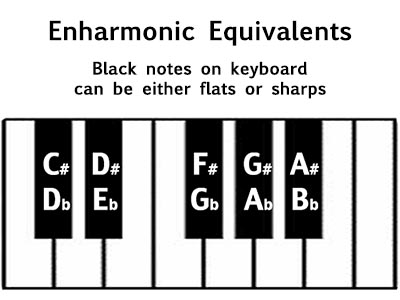Enharmonic notes are notes that look different on paper but sound the same. They might seem confusing if you’re new to reading sheet music. However, once you grasp their concept, they become simple. Moreover, recognizing enharmonic equivalents improves your music reading skills. This article will clarify enharmonic tones. Let’s begin.
What does “Enharmonic” mean in music?
In music theory, enharmonic tones refer to notes that sound the same but have different names.
Western music notation uses letters (A to G) with sharps and flats to adjust pitch. This can lead to notes with the same pitch but different names.
For instance, C# and Db are enharmonic equivalents – they sound the same but look different in notation.
Enharmonic equivalents can be notes, keys, or chords. For example, C# and Db Major keys are enharmonic, although they have different notations. C# has six sharps, while Db Major has five flats.
You might find one easier to read than the other!
Enharmonic Keys
Enharmonic keys are pairs of keys that sound alike but look different on paper. For instance, G flat major and F sharp major are enharmonic.
They use the same notes but are written with different symbols. G flat major often has six flats, while F sharp major has six sharps.
Composers get to choose which one to use. Sometimes it depends on what feels more comfortable for playing or writing music.
But it can also be based on the composition’s other keys or chords. Imagine a piece that switches to the fifth note of the original key in its second part. To keep things harmonious, the new key often has the same letter name as the original key’s fifth note.
So, if you were in B Major, you’d go to F# Major instead of Gb major, since B major has an F#.
Even though the Gb and F# keys are enharmonic and sound the same, it’s easier for sight readers to stay in a key with sharps than to switch to one with flats.
This is a simple example, but there are other times when composers decide on enharmonic notes based on the context, like certain chords and scales.
How to Spot Enharmonic Notes
Recognizing enharmonic notes helps you read sheet music more easily. Here are 4 tips for identifying enharmonic tones, chords, and keys:
- Learn Your Scales: Practicing all 12 keys and their signatures might seem daunting, but it’s crucial for musicians. It helps you spot enharmonic spellings effortlessly.
- Consider the Context: Take note of the key signature and the notes around it. A note’s spelling often depends on its musical context.
- Understand Intervals: Knowing the intervals between two notes can help you decide if it should be sharp or flat.
- Practice Reading Music: Regular practice in reading sheet music naturally enhances your ability to spot enharmonic equivalents quickly.
Enharmonic tones are a simple concept once you grasp the basics. It’s one of the peculiarities of musical notation that might seem tricky at first, but it won’t hold you back. If you’ve read this article, you now have a solid understanding of enharmonic tones.



